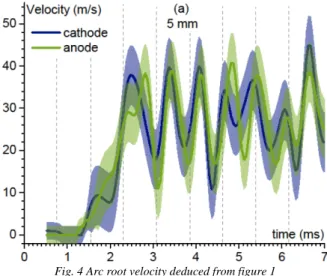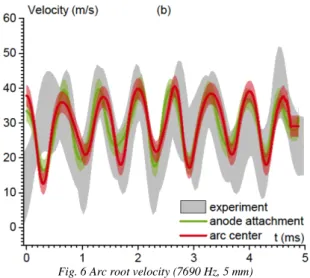HAL Id: hal-02152809
https://hal.archives-ouvertes.fr/hal-02152809
Submitted on 11 Jun 2019HAL is a multi-disciplinary open access archive for the deposit and dissemination of sci-entific research documents, whether they are pub-lished or not. The documents may come from teaching and research institutions in France or abroad, or from public or private research centers.
L’archive ouverte pluridisciplinaire HAL, est destinée au dépôt et à la diffusion de documents scientifiques de niveau recherche, publiés ou non, émanant des établissements d’enseignement et de recherche français ou étrangers, des laboratoires publics ou privés.
Numerical and experimental study of arc fault in
aeronautical conditions
Jean-Marc Bauchire, M. Lisnyak, Hervé Rabat, M. Chnani, Audrey Bigand,
Christine Espinosa
To cite this version:
Jean-Marc Bauchire, M. Lisnyak, Hervé Rabat, M. Chnani, Audrey Bigand, et al.. Numerical and experimental study of arc fault in aeronautical conditions. 22nd International Confrenence on Gas Discharges and Their Applications, Sep 2018, Novi Sad, Serbia. pp.1-3. �hal-02152809�
an author's https://oatao.univ-toulouse.fr/23454
Bauchire, Jean-Marc and Lisnyak, M. and Rabat, Hervé and Chnani, M. and Bigand, Audrey and Espinosa, Christine Numerical and experimental study of arc fault in aeronautical conditions. (2018) In: 22nd International Confrenence on Gas Discharges and Their Applications, 2 September 2018 - 7 September 2018 (Novi Sad, Serbia).
NUMERICAL AND EXPERIMENTAL STUDY OF ARC FAULT IN
AERONAUTICAL CONDITIONS
J.M. BAUCHIRE¹*, M. LISNYAK¹, H. RABAT¹, M. CHNANI², A. BIGAND
3, C.
ESPINOSA
3¹ GREMI, Université d’Orléans, 14 Rue d’Issoudun, 45067, Orléans, France
² Zodiac Aero Electric, 7 Rue des Longs Quartiers, 93108, France
3
Institut Clément Ader ICA, Université de Toulouse, ISAE-SUPAERO, 31400 Toulouse, France
*jean-marc.bauchire@univ-orleans.fr
ABSTRACT
The use of electrical energy is constantly increasing in airplanes. This concerns needs in motor, actuators or those related to services for example. Naturally the electric energy-related risks increase. Arc discharges can appear with consequences that can be dramatic.
The electrical constraints to which a plane is subject are not only internal. The aircraft are also regularly struck by lightning in-flight. Composite materials, increasingly used, make more difficult the management of these risks of lightning strikes.
So the arc discharge is a concern in the aeronautical domain. This specific area imposes special conditions that do not exist in other areas where the arcs are present. Our intervention is intended to present these studies, with in the rest of this paper, references to two specific topics, the arc fault in the electric core of aircraft and damage to the composite by structure being struck by lightning.
1. INTRODUCTION (PART 1)
The study is devoted to the investigation of arc fault phenomena in the electrical network of aircraft. Generally, the power distribution system of an aircraft plays an essential role and is needed to distribute the electricity from the generators to all kinds of electrical equipment and to the commands to control the plane.
These main conductor lines are called busbars and act as a distribution centre for the electric power. The electrical power distribution system is based on one or more busses.
In general, the busbar systems are robust and thoroughly designed to prevent any internal bus crossing. However, with time, the vibrations which take place during flight can cause an arc fault to be initiated between busses. Another source of arc faults is so-called foreign object debris (FOD).
A FOD may appear in the distribution network for different reasons, for instance a screw falling because of vibrations, fluid droplets due to a leakage: Figure 1 depicts the bus bar system after arcing.
Fig. 1 Example of busbars after arcing [1]
2. EXPERIMENTAL STUDY OF
ELECTRIC ARC DISPLACEMENT BETWEEN BUSBARS
A variety of powering conditions exist in a plane, depending on the position in the electric network. We have studied some sets of operating parameters, the ones where the arcs occurrence probability is high:
• The inter-electrode gap h is 5 or 8 mm. • Electrodes are in aluminium.
• Frequencies of alternating current are 420 Hz or 760 Hz.
• Power supply RMS voltage is 115 V or 230 V, leading to short circuit current
from 400 A to 2 kA and depending on the whole system impendence.
• The arc ignition is realized with a wire placed between busbars.
For each shot, electrical parameters (current and arc voltage) are recorded. Arc displacements are recorded with a high-speed camera (Photron SA5).
Fig. 2 Sequence of frames from high-speed video (760Hz, h=5mm)
Fig. 3 Current and arc voltage (760Hz, h=5&8mm)
Figure 2 shows a sequence of frames from high-speed video of an arc propagation, with 230 V, 760 Hz and h = 5 mm as operating parameters. Current and voltage waveforms of the arc are given in figure 3.
Contrary to other cases, the arc propagates without any restrike, with characteristic shape as describe in [2]. The arc root displacement velocity is presented in figure 4. The minimum arc speed occurs when the arc current crosses zero. The arc acceleration and deceleration dynamic are correlated with the discharge frequency.
Fig. 4 Arc root velocity deduced from figure 1
However, in this case, it can be seen that the arc speed reaches a limiting propagation speed of about 40 m/s.
3. NUMERICAL STUDY OF ELECTRIC ARC DISPLACEMENT BETWEEN BUSBARS
In order to predict the displacement of the arc fault for different operating conditions, a 3D self-consistent mathematical model was developed. It is based on magneto-hydrodynamic equations including electrode material. The system of MHD equations is solved by commercial software COMSOL Multiphysics®.
Figure 5 and figure 6 give a comparison between results obtained by simulation and the ones presented in the previous section. Both computed and measured velocities of the arc are plotted together. The curves corresponding to the experimental data are displayed in gray within the error interval.
The arc column voltage calculated with the model is lower than in the experiments, as the calculated voltage is the one of the arc column which does not take into account the voltage drops. Nevertheless, a similar trend of the arc voltage waveform can be seen, i.e. overshoots when current reaches zero amps.
Fig. 5 Arc current and voltage waveforms (750 Hz, 5mm)
It should be emphasized that the time duration of these overshoots predicted by the simulations is the same as that measured in the experiments. A stabilization period of the voltage follows the overshoot at a constant value.
Regarding the arc behaviour, the comparison will focus on the arc velocity of the arc centre and of the cathode attachment.
Fig. 6 Arc root velocity (7690 Hz, 5 mm)
The excellent agreement on the arc velocities between the experiments and the numerical model validate the possibility of extending the model to a wide range of current regimes and of seriously considering the results of the simulations for lower pressures.
The remarkable consistency of the simulation outcomes with the experimental measurements
validates and supports the role of the present model as a predictive tool of arc behaviour with respect to its limitations based on the model assumptions.
4. LIGHTNING ARC INTERACTION WITH COMPOSITE STRUCTURE (PART 2)
Lightning is a natural phenomenon producing extremely high current of few microseconds to few milliseconds. The lightning damage mechanism for carbon laminate aeronautical structure is a complex multi-physical phenomenon.
For example, the very fast vaporisation of the metallic lightning strike protection, which is a thin copper mesh (figure 7), generates an overpressure that damages the composite structure.
Fig. 7 Lightning strike protection principle (Expanded Copper Foil)
In order to study this phenomenon, current density has been assessed in each wire of the mesh and joule heating computed to predict explosion time. This model is compared to the results of an innovative test approach in which lightning current pulse is injected into a wire, representing an elementary part of the mesh. On the other hand, it could be interesting to understand and predict the interaction of the lightning arc with the aircraft structure. Two parts of the arcs follow different behaviours. First the arc column for which the expansion follows the rules of the MHD equations with a quick pulse of current and the arc root area with an expansion depending on the properties of the metallic lightning strike protection and the confinement effect of the paint covering the structure. This theory has been studied through multiphysics models and lightning lab tests. REFERENCES
[1] Zodiac Aero Electric, private communication, 2017.
[2] P. R. Zeller and W.F. Rieder, IEEE
Transactions on Components and Packaging Technologies, 24 (3), 337-341, 2001.
![Fig. 1 Example of busbars after arcing [1]](https://thumb-eu.123doks.com/thumbv2/123doknet/12397948.331785/3.892.458.786.617.751/fig-example-of-busbars-after-arcing.webp)

